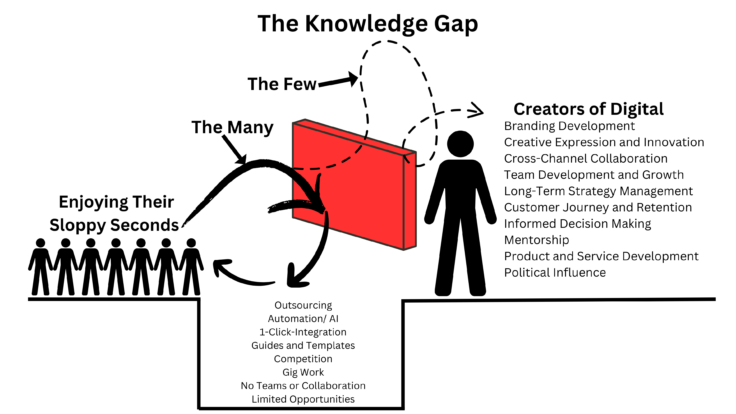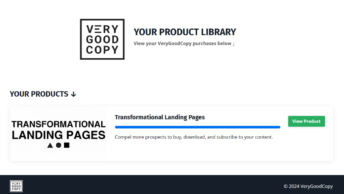The digital world was new and fun for a few decades, then it became about power, wealth, and authority. Now it all ends with a new generation left to clean the slop, if they are ever given the chance.
In less than a generation, digital went from an unknown quantity to transforming society, to a bust.
Those early voices who changed everything took something analog and offered it digitally. They invented codebases, built software off that code, designed hardware and network solutions, and connected it all within ecosystems. All of it was done from scratch without any clear end goal.
Now that everything that should be digital is digital, businesses, investors, and those who once led innovation have given up.
There are still new things in the pipeline, but not in the same way as yesteryear. All of it is announced with some financial motive and how it will be taken from someone else and given to themselves, all with less ownership and freedom for the user. Everyone has to create the next big thing. Fewer people can simply create to make things better.
This comes with a secondary problem. Expectations are increasingly unchecked. There is still success to be had, but growth metrics do not look like they did a decade ago. Instead of saying this is not as good but still more than enough, companies slash investments, shrink teams, consolidate, standardize, and outsource as much as possible.
Thankfully, some companies keep the furnace hot enough for the corpses of unmet potential to go cold entirely. After all, they have to do something – the bare minimum.
Those corpses are anyone in the world today born too late to ever take advantage of what digital once had to offer. No more opportunity, no more space for creation, and more greed. Very few get to make it, with most of those being nepo-hires or the truly exceptional who can directly impact the bottom line in a big way.
The good news is that one day, those who created all of this will finally move aside. The bad news is that what is left will be a pile of slop, and no one will have the skills to clean it up.
This is where we are today:

On the right side are the Creators of Digital, described in the opening section. They own almost everything, hold leadership positions across businesses, and dominate the influencer space.
This group built everything from scratch and worked to reshape modern society, its economy, and access to information and conveniences. They did incredible things, brought like-minded people together, and created, created, and created some more.
On the left side are those getting their Sloppy Seconds. They are college graduates, highly creative or intelligent individuals, and those displaced due to one of many possible economic and business decisions looking for a different opportunity. They have no mobility in the digital era. They are shoved into an endless cycle of never learning valuable skills, being unable to apply themselves to worthwhile ventures, and being grossly underappreciated for their potential.
This group also looks to the right side, the Creators of Digital, for guidance.
Looking to the right side is a problem.
The Right Side, Right Out of 2015
For all of their good, Creators of Digital are, either wittingly or unwitting, making sure that as few people as possible can thrive in the world of their creation.
To understand how digital in 2025 is slop, we must look back at the years between 2005 and 2015, which were peak digital.
During this time, improvements in hardware, software, and network availability, combined with the broader adoption of computers, led to a feeding frenzy.
This opened the door to success, not necessarily because of brand development, strategy management, customer journeys, and all the other good stuff digital leaders claim led to their success. Rather, it results from people taking advantage of a lack of competition, fragmented ecosystems, and immature processes. With these winds in their sails, an entire generation of people forged exploratory paths through digital with what today we know to be gimmicks, tricks, and hacks. A more fair word might be tactics.
These tactics allowed this group to win in social media, email, video, SEO, e-commerce, online advertising, and so on. They could spend one dollar to make 10, 100, or 1,000 dollars.
Gratefully, the effectiveness of these tactics peaked a decade ago. This partially came from growing competition that copied tactics, combined with the maturation of ecosystems that began to punish those tactics for being exploitative.
It’s not that anyone should be blamed. It was good business, but it also generated a lot of slop.
This slop was necessary to win. You could focus on ethics and quality, which often meant being slower. In today’s society, adhering to ethics and quality will not prevent another person from churning and burning.
Again, there was a lot of good stuff mixed in all of this. The future looked amazing. We had memorable memes, blogs tackling topics rarely discussed in traditional media, forums where people connected, websites that opened the doors of creativity, social media platforms where people met, video hosting sites that saw explosive creativity, and a million other things while they lasted.
But in 2025, it is arguable that the good stuff is not the norm.
How is it not the norm? When money no longer flowed so freely and the new normal would not satisfy hungry investors and those seeking more authoritarian ends, those who created all of this chose to double down, slash their marketing budgets, shut down research and development, ditch their ethics policies, sell to investors, and tighten their grip on the entire digital sphere to keep it for themselves.
What does that look like today?
Open your email and see that one company has sent you the same sales promotions three times today. Go to any social media platform and see every Chuck and Sally with a bought email list and bot follower count desperately spamming you to buy their affiliate crap or webinar or book that promises you everything without anything in return. Once-loved blogs have become advertising nightmares with no journalists left. Websites all look and feel the same, have no unique take on stories, and are overflowing with SEO garbage. Social media is sold on connections but is a way to farm your data and is carefully designed to make you scroll and lose hours of your day. Everyone has to have an app, wants to know your location, and requires an account. Your toothbrush has Bluetooth. Advertisers just look for what is trending and create media around what is deemed safe, or they try to drag once-upon-a-time 80s or 90s actors out of retirement to remind us that we used to like things. Everything is a subscription. You are not supposed to own anything. A handful of tech companies are also e-commerce stores that sell disposable garbage, media companies, and news publications, and they are teetering on becoming influencers of an authoritarian government. Instead of making new things, companies triple down on making only one product and adding more and more features under the guise of newness while no longer supporting the previous thing just to get you to buy it again or can’t repair it. And that is only a starting point.
None of this will go away either. The Creators of Digital remain the gatekeepers who prevent anyone else from having the influence that could reshape things for the better.
But how did they become gatekeepers?
The Creators of Digital went one of two ways: They went into corporate or became influencers.
If they moved into corporate, they have worked to manipulate feckless CEOs and middle-managers who are decades behind the times with the allure of the promises of digital that once was. This afforded them lucrative senior positions. Once on the inside, their tactics faltered yet again. So, to buy time, they gutted teams, outsourced everything, and bought out competitors to make the business look efficient while promising that their failings were just headwinds and that the next tactic would arrive soon. At the same time, they closed off, didn’t learn anything new or seek to pass on knowledge, and refused to give others the same opportunity they had.
The other path was to become an influencer.
The influencer path is the worst because these folks are more overt about how many businesses they started and sold (without evidence) and how much money they made (without evidence). They will suggest that those on the left, who are forced to endure the Sloppy Seconds, can, too. Except this is the exact reason we call it Sloppy Seconds. They are making and selling courses because the tactics they used to become successful no longer work. The barrier to entry is too great even for them.
But everyone is listening to and learning from them. This worsens the situation because instead of going out and experimenting and trying new things, a new generation trying to step into digital has the mindset of that influencer. That all things should be guided by wealth and authority and come easily. When what they need to hear is that they should throw out the baby with the bathwater and try new things even if it does not mean success.
Should we expect the receivers of Sloppy Seconds to ever succeed?
The Left Side, Left to Mop That Slop
Shoveled into social media, within someone else platform where there is little ownership, too much competition, and skills development that is rarely applicable to the needs of the products and services that most people want or need, this group is most certainly enjoying their Sloppy Seconds.
In the boom times, when everything was new, people were trying things, and even if they failed, it was easy to do something else, provided you could learn on your own or find other people willing to join in.
That was a generation where you could work construction, never having used a computer, and then transition into a designer, a writer, an email or social media marketer, or just about anything else, not in 2025, and not anytime again in the future.
Worse of all, those Creators of Digital have put up impossible barriers. Remember, that group is spreading a message that does not align with the current situation. They want consolidation, control, and more and more wealth. Thus, there are few, if any, opportunities to get into a field related to digital. Instead, they tell everyone else that success is having more followers, selling courses, and talking like a lifestyle guru. There is little opportunity to grow, no collaboration, and no long-term direction.
This is why we have a knowledge gap, and it will only get worse in the future.
Those who overcome those barriers will find themselves on a team with very few people, all with titles that are “Senior” or “Director,” but their only role is managing contractors, downloading guides, or installing templates. Directed to feed the furnace to keep their own corpses warm enough to make it look like things were okay.
Even when they want to do more, they can not.
The contractors they work with do not have the skills to help. If a direct supervisor is motivated, it does not mean they will get approval to try new things because there is such a focus on efficiency and cost-cutting. Nobody wants to raise their hand to say that none of this is working out of fear that their position will be considered redundant or that they are a problematic employee.
None of this is exclusive to digital. It is why companies are led overwhelmingly by older individuals who have failed to promote from within, offer mentorship or education opportunities, and then turn around and complain about nobody having the right skills and not wanting to work. Every business wants a labor force composed of experts, but no company wants to contribute anything toward creating that skilled labor force.
The labor force needs a larger pool of people with the skills necessary to create things again or to be given the room to try and fail.
Unfortunately, only those in charge can allow that to happen. But that is unlikely to change anytime soon. The solution is not for every person to want to be a YouTuber or influencer and see that as the only pathway in life.
Undoing this damage will be a long and drawn-out process. If everyone at the top stepped aside today, it would take a decade or longer for things to start to change, assuming large tech giants and money-hungry investors do not squash anything that opposes their dominance.
How to Avoid Sloppy Thirds
Some things can be done easily, but more significant issues will persist because a few large companies own everything.
The easily solvable problem is to close the knowledge gap. As detailed in the graphic above, those currently receiving sloppy seconds deserve opportunities to learn and apply skills that cover branding, creative expression, and innovation, collaborating with internal and external teams with broad skill sets (not just contractors), internal development and growth, strategy management over the years (not quarters), customer journey and retention strategy, making decisions that fit the goals of each department and the vision of a product or service, receiving regular mentorship from those who are not influencers or money hungry, developing product and services, and the ability to navigate regulation and laws.
This requires all companies to divest the requisite resources to make it happen.
The significant issues are linked to tech monopolies and how investing currently works. Tech monopolies work by buying out any company that tries to come to market with a new product or service that might undercut their dominance. While you might argue it is the fault of a company for selling to the other company, it is important to recognize that a tech monopoly has so much money and influence they can quash whatever they do not want to deal with in less apparent ways.
On that same note, investors want to give money to people with grandiose ideas who can scale a project in a few short years and then sell it for a large sum. There is little desire left to create something that grows and is sustainable over twenty years.
AI complicates this. Today, the desire is to automate every existing process. This would work if the current processes were good. But as detailed already, doing more of the same at a faster clip will only produce more garbage. Only this time, if AI is churning it out and no human opportunities exist, will it not matter. When those tech monopolies begin broadly applying AI, it will be game over.
And that is how this ends. The digital world was new and fun for a few decades, then became about power, wealth, and authority. It ends with AI taking the worst of it all and spitting it out faster than humankind could ever hope to produce in a lifetime.
Might there be a brighter future? All things are unknown about the future. Nobody knew what digital would become when it first started. But we can make sound predictions and look for trends.
There is a lot of pent-up frustration and a desire to change things. We can see it each day. It would be awesome to see this moment unifying enough people to create the change they want to see. If nothing, each person, each day, can learn something new for themselves, offer help to anyone who needs it, and stop supporting companies and calling out influencers that continue to misalign with the ethics and values we want in our digital spaces.



